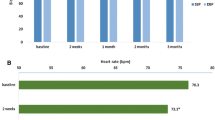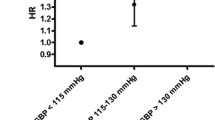Abstract.
Objective: The aim of this study was to measure the time–effect profiles of a once-daily administered valsartan/hydrochlorothiazide combination and amlodipine on blood pressure using various indices derived from 24-h ambulatory blood pressure (BP) monitoring. Methods: Of the 310 randomized outpatients with uncomplicated mild-to-moderate primary hypertension, 259 (133 on valsartan/hydrochlorothiazide, 126 on amlodipine) were eligible for analysis. After a 2-week placebo wash-out period, the patients were randomly allocated to treatment with either valsartan 80 mg once daily (o.d.) or amlodipine 5 mg o.d. for 4 weeks; in the case of an unsatisfactory blood pressure response, the treatments could be respectively changed to the fixed combination of valsartan 80 mg plus hydrochlorothiazide 12.5 mg o.d. or amlodipine 10 mg o.d. for a further 8 weeks. The trough:peak ratio (global and individualized approaches) and smoothness index (i.e., the ratio between the average of the 24-hourly BP changes after treatment and the corresponding standard deviation) were calculated from 24-h ambulatory blood pressure recordings made after the placebo period and after 4 weeks and 12 weeks of active treatment. Results: Both regimens effectively lowered systolic and diastolic ambulatory pressures after 4 weeks and 12 weeks (all P<0.001) but, among the responders, the valsartan/hydrochlorothiazide combination had a greater antihypertensive effect during the night-time hours after 12 weeks (P=0.03/0.02). In the responders, the placebo-adjusted, mean trough:peak ratios were 0.76/0.74 in the valsartan/hydrochlorothiazide group (n=111) and 0.66/0.62 in the amlodipine group (n=101).The corresponding global trough:peak ratios were 0.61/0.57 for the valsartan/hydrochlorothiazide combination and 0.56/0.56 for amlodipine. However, the between-group differences in individual or global trough:peak ratios were not significant. The smoothness index was slightly, but insignificantly, greater for valsartan/hydrochlorothiazide than for amlodipine in the responders and the groups as a whole. Conclusion: Valsartan/hydrochlorothiazide and amlodipine were equally effective in reducing ambulatory BP, but the valsartan/hydrochlorothiazide combination led to more homogeneous BP control during the inter-dosing interval. Trough:peak ratio and smoothness index did not reflect this finding accurately.
Similar content being viewed by others
Author information
Authors and Affiliations
Additional information
Accepted in revised form: 28 September 2001
Electronic Publication
Rights and permissions
About this article
Cite this article
Palatini, P., Malacco, E., Di Somma, S. et al. Trough:peak ratio and smoothness index in the evaluation of 24-h blood pressure control in hypertension: a comparative study between valsartan/hydrochlorothiazide combination and amlodipine. Eur J Clin Pharmacol 57, 765–770 (2002). https://doi.org/10.1007/s00228-001-0393-6
Received:
Published:
Issue Date:
DOI: https://doi.org/10.1007/s00228-001-0393-6




